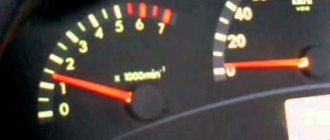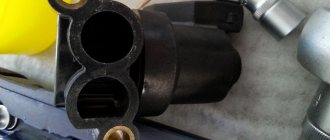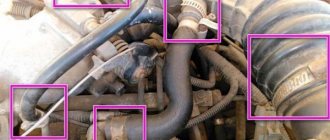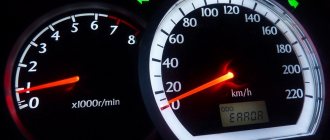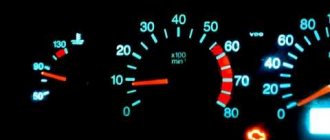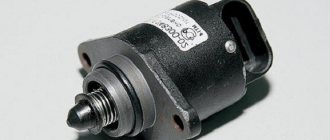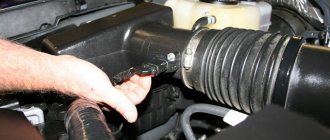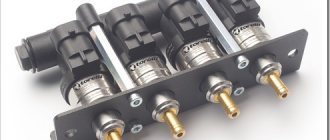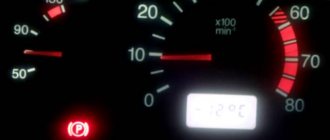Drivers’ complaints that whenever the engine heats up, strange things begin to happen with the speed (the so-called “floating effect”), it is not so rare to hear. This unpleasant incident is inherent in gasoline engines that have injection, carburetor formats, as well as engines running on diesel fuel. If, when the engine warms up, the speed suddenly slows down, this is a sure signal that something unexpected has happened to it and you need to immediately look for the cause and fix the problem.
Eliminating the problem of floating engine speed.
The reason for the appearance of floating speed
If the speed fluctuates on a warm engine under load or in idle mode, you should immediately carry out a comprehensive diagnosis of the car so as not to aggravate the situation. But at the initial stage of the study, it is advisable to understand the peculiarities of the floating speed. An ordinary tachometer will help to record this. If everything is fine with the engine, the tachometer will record stable readings at approximately the same level (about 800 rpm), without sudden jumps. However, if something is wrong with the engine, the range of tachometer readings will rapidly increase, ranging from 500 to 1500 revolutions per minute.
The presence of floating speed is also proven by the amount of engine rumble, which from time to time either increases or decreases. In addition, vibrations of varying strengths that change like a sine wave begin to be clearly felt inside the car from the engine. Such incidents are most often recorded during unstable engine speeds, which operate in idle mode.
However, tachometer “jumps” are sometimes observed during intermediate engine speeds, which is typical for diesel engines. If there are deviations from the norm, the tachometer may show a completely unimaginable speed range. For example, from 500 to 1000, and then to 1500 rpm, after which they rapidly fall, in the reverse order, to 500 rpm. This is clearly noticeable when the load on the engine increases:
- after pressing the brake pedal;
- rotation of a steering wheel equipped with a hydraulic booster;
- turning on the air conditioner;
- when driving transitional type and so on.
In such cases, the engine at idle, in the absence of excess load, manages to keep the speed stable, but as soon as it appears, the speed immediately drops and the engine almost stalls. Additional “noises” include an unreasonable increase in fuel consumption and other factors.
Idle mode
Idle speed is the operating mode of a car engine with the gear in neutral. It is characterized by minimal engine load and low fuel consumption.
Idle mode is used:
- for delivering motor oil from the engine crankcase to friction units after a long period of parking the vehicle;
- to warm up the power unit in the cold season;
- in cases where turning off the motor is impossible or undesirable.
During normal engine operation, the crankshaft speed is idling at 2000 rpm. gradually decrease to 800, then maintaining at this level. However, it also happens that the power plant, when switching to this mode, operates unstably - it randomly changes the speed in the range of 500–1500 rpm, “chokes” and stalls. This tells us: a failure has occurred in the engine control system, the causes of which must be diagnosed and eliminated as soon as possible.
The movement of the instrument needle shows a change in the number of engine revolutions.
Determining the specific cause that caused the malfunction is not easy, but it cannot be ignored - this can lead to critical engine failure and the need for expensive repair work. In addition, driving a car with an engine that is unstable at idle speed distracts the driver's attention. He has to constantly monitor changes in the speed and keep his foot on the gas pedal, preventing the engine from stalling when braking or stopping briefly.
Methods for solving the problem
Having detected a floating speed, experienced drivers begin checking the relevant electronics. During diagnostics, special attention is paid to the throttle assembly, as well as sensors and actuators. The operation of other mechanisms also needs to be diagnosed, including the ignition system and idle speed control, as well as air and fuel filters, injector nozzles, etc. There is especially a lot of hassle with the regulator and air flow sensor. Based on the results of a thorough diagnosis, it often turns out that the whole reason is a heavily contaminated throttle valve, which for this reason does not close as it should, or mechanical damage to the throttle. In the first case, careful cleaning of the valve immediately gives a positive result, but in the second case it is best to replace the throttle with a new one.
Description of defects causing uneven operation of the motor
When excess air masses enter, the electronic control unit (ECU) sends a signal that requires restoring the balance between the air masses and the flammable liquid to create an air-fuel mixture. With additional fuel supply, the speed increases. Accordingly, in order to stop the excessive supply of fuel, the speed is automatically reduced and noticeable jumps occur.
IAC breakdowns can be caused by a violation of the integrity of electrical wires or regulator failures due to the use of low-quality fuel mixtures. When the IAC breaks down, the car engine loses stability, the speed jumps, randomly increasing and decreasing.
Crankcase gases enrich the air-fuel mixture in the intake manifold. If their flow into the manifold is disrupted, the speed when starting the engine when cold is reduced to 750 instead of 1200 rpm. Jamming of the ventilation valve occurs due to the presence of excess oil deposits on the crankcase walls.
A breakdown of the crankcase mass air flow sensor can be caused by an excessive layer of used oil film. Failure of the DMVR can also occur due to a breakdown of the hot-wire anemometer that monitors the air in the cylinders. The electronic control unit receives distorted data, additional portions of air are supplied to the combustion chamber, as a result of which the engine speed becomes unstable.
The throttle valve may become stuck due to a build-up of waste oil preventing it from closing and opening, or due to a broken drive mechanism. This defect is the most common in carburetor cars. They also experience uneven engine operation at idle speed.
IAC sensor
The cause of engine operation deviation from normal parameters may also be a malfunction of the idle air control sensor (IAC). The whole point is that in cars, as a rule, it is not supplemented by a self-monitoring system, so on-board computers or check-angers do not signal its breakdown. However, floating speed is one of the key signs of a malfunction of the IAC sensor, so it needs a thorough inspection and, if necessary, its repair or even replacement, especially since its cost is relatively low.
Interruptions in the operation of carburetor and diesel engines
Why do engine speeds fluctuate in carburetor cars? Unstable activity may be caused by the following reasons:
- Failure of adjustments in idle modes.
- Failure of the carburetor engine solenoid valve.
- Excessive accumulation of combustion products in the nozzle.
Diesel engines have jumps and drops in the instrument readings during intermediate modes and when idling. In these cases, they say that the diesel engine speed is floating. The cause is rust formed on the impeller of the high pressure fuel pump. Water contained in diesel fuel causes corrosion.
Consequences of unstable motor activity
All of the above reasons for engines running intermittently cause a number of negative consequences:
- increased consumption of gasoline or diesel fuel;
- environmental pollution with exhaust gases containing an increased percentage of harmful gases;
- increased wear of components and parts of the power unit.
To avoid the negative impact of stability failures in the operation of internal combustion engines on the functioning of all vehicle systems, it is necessary to carry out regular checks of all sensors and components of the unit.
Throttle valve
As noted above, increased idle speed of a car on a warm engine may be a consequence of the fact that the throttle valve is dirty. The dirt that has accumulated on it over time does not allow it to close freely and completely, as intended, so it must be thoroughly cleaned. At the same time, some drivers note with surprise that sometimes even thorough cleaning of the damper along with the idle air valve is not enough. So, the engine still maintains high speeds, and the brake pedal loses its elasticity, becoming very hard. Then, according to experts, you will have to start cleaning the VVTi valve. There are also recommendations to start flushing the idle air valve.
Brake booster malfunction
The vacuum brake booster can only operate when the engine is running. The vacuum chamber of the brake booster communicates with the intake manifold, where a vacuum is created, through a check valve and a connecting hose or tube. When the engine stops, the check valve closes, disconnecting the vacuum chamber of the amplifier and the intake manifold.
When the engine is off, the brakes operate only from mechanical force directly on the pedal. The amount of vacuum remaining in the chamber may only be enough for two or three brake presses without applying excessive force to stop the car.
A malfunction of the check valve or the vacuum seal itself also leads to air entering the system during braking. As a result, the mixture becomes leaner and the car stalls. The malfunction can occur both on cars where the carburetor is responsible for supplying fuel, and on the injector.
It is easy to check the performance of the vacuum booster. Just hold down the brake pedal and start the engine. A working vacuum booster will make the pedal softer and when you start the engine it will feel like it will fall. Otherwise, replace the check valve or amplifier.
Electronic control unit
According to the observations of experts, most often the phenomenon of floating speed at idle is inherent in injection-type engines, in which regulators “assigned” to it - electronic engine control units - are responsible for idling. They are designed to constantly analyze data on the functioning of the idle speed, and when failures occur, to give the appropriate mechanisms a command to correct the errors. Therefore, the cause of floating speed is often a breakdown in the electronics.
Having discovered the effect of floating speed in a car, the driver needs to take this seriously so that the situation does not worsen and does not lead to serious engine damage, and its large-scale repair, as we know, is always expensive. Therefore, it is better to conduct a thorough diagnosis of the car, and if in the process it is discovered which part or unit is faulty, replace it with new ones, after which the engine will work normally.
avtoexperts.ru
The engine is the “heart” of a car, and like the human heart, interruptions sometimes occur in the functioning of this “organ”. We become aware of problems with the engine by reading the rpm. If the speed of the power unit begins to float, the engine gives us a signal that something is wrong with it. In our material today we will tell you what breakdowns are hinted at by jumping engine speeds, how to correctly diagnose and repair them.
Hyundai floating speed
The reason for the appearance of floating speed
The driver can find out that there is something wrong with the engine speed by looking at the tachometer. During normal operation of the power unit at idle, the needle of this device remains at the same level (usually within 750-800 rpm), and if the engine has problems, the needle either falls or rises (range from 500 to 1,500 rpm and higher). If the car does not have a tachometer, then the floating speed can be heard by ear: the rumble of the engine either increases or decreases. And also - by the increasing and decreasing vibrations penetrating into the car interior from the engine compartment.
As a rule, unstable engine speed occurs at idle. But even at intermediate engine speeds, dips or rises in the tachometer needle can be detected - this is typical for diesel engines. Let's consider these two cases separately to understand why these phenomena occur.
Speed jumps at idle
Floating idle speed most often occurs on injection engines. This is due to the peculiarity of regulating the operation of the idle system by the electronic engine control unit (ECU). The electronic “brains” of the car constantly read information about the idle speed, and if it is violated, they give a command to the sensors responsible for the correct functioning of the system to correct the situation. Idling may be disrupted due to excess air getting into the fuel system, and specifically into the engine cylinders. In this case, the mass air flow sensor signals the ECU that excess air has entered the combustion chamber. To equalize the amount of air and fuel that together form the air-fuel mixture, the “brains” command the injector valves to open and let more fuel into the cylinders. At this moment, the engine speed increases sharply. Then the ECU “realizes” that it has supplied too much fuel to the cylinder and limits its supply - at this moment the speed drops sharply.
The second reason for floating speed at idle is the failure of the idle speed controller (IAC).
Removed the idle air regulator (IAC)
It is an electric motor, the design of which includes a conical needle, and its function is to stabilize the engine speed when it is idling. The main reason for its breakdown is wear of the IAC elements (wire breakage, wear of guides or cone needle drive, etc.) due to long-term operation of the vehicle on low-quality fuel. When the regulator breaks down, the engine, left without a “stabilizer,” begins to involuntarily increase or decrease speed.
The third reason for speed fluctuations is a malfunction of the oil sump ventilation valve.
oil pan ventilation valve
During engine operation, exhaust gases accumulate in the crankcase (they are also called crankcase gases). If the engine is new, then the volume of such gases in the crankcase is relatively small, while an engine with high mileage has an increased amount of crankcase gases. Excess of these gases is removed through the ventilation system to the intake manifold and throttle valve, where they participate in the formation of the air-fuel mixture in the engine combustion chambers. If the crankcase ventilation valve jams (usually this happens due to the deposition of oil residues contained in the crankcase gases on its walls), a smaller amount of crankcase gases enters the intake manifold, the fuel injection valve is not fully enriched, and the engine speed begins to fluctuate - from average ( 1100 - 1200) to low (750-800).
The fourth reason for the appearance of floating speed at idle is the failure of the mass air flow sensor (MAF).
mass air flow sensor (MAF) Lada 2110
It, like the crankcase ventilation valve, can become covered with a dirty oil film during long-term operation, which ultimately leads to its failure. Quite rarely, the hot-wire anemometer in the mass flow sensor breaks down - the element responsible for measuring the volume of air entering the engine combustion chamber. In this case, the ECU does not receive correct data on the mass air flow and requires it to be supplied to the cylinders, which results in jumps in engine speed.
The fifth reason is incorrect operation of the throttle valve, the function of which is to regulate the air pressure supplied to the engine cylinders.
throttle valve
It can jam for two reasons: an oil deposit appears on the inner surface of the valve “penny”, which prevents the valve from closing and opening normally, and also due to a malfunction of the throttle valve drive. Note that this is the most common reason for the engine operating with floating speed at idle, which is also typical for carburetor engines.
Speaking about carburetor engines, we list the reasons why they may experience jumps in idle speed. This is a) incorrect adjustment of the engine idle speed; b) breakdown of the carburetor solenoid valve; c) clogging of the idle jet with fuel combustion products.
Carburetor 21073 Solex
Speed jumps during intermediate travel
In diesel engines, floating speeds during intermediate stroke are mainly due to the formation of rust on the blades in the high-pressure fuel pump. Corrosion of these pump parts occurs due to the presence of water in the fuel. By the way, for the same reason, the speed of a diesel engine also jumps at idle.
Bosch injection pump - view of the centrifugal regulator
All of the above reasons for the appearance of unstable engine speeds have several consequences: increased fuel consumption, the release of exhaust gases with a high CO content into the atmosphere, wear and tear on the elements of the fuel system and the engine air supply system. To prevent this, it is necessary to periodically check the operation of the systems and sensors listed above, and if trouble does occur and the speed is “feverish”, immediately repair all breakdowns.
You can diagnose the cause or prevent its occurrence in advance using the Rokodil ScanX multi-brand scanner.
Diagnostic scanner Rokodil ScanX
By comparing the readings with the specifications from the manufacturer, you can definitely determine whether the system is working properly. If errors are detected after diagnostics, Rokodil ScanX will more accurately indicate the problematic element and where to start the inspection first. For example, errors P0100-P0104 will indicate a malfunction related to the mass air flow sensor, P0518 will indicate an IAC, etc. This procedure will help you more accurately determine the cause of the malfunction and save time in detecting it.
Correcting floating engine speeds
1. Air leaks into the engine cylinders . It is necessary to check the tightness of the air supply lines to the intake manifold. To do this, you can remove each hose individually and blow it out using a compressor or pump (a labor-intensive process), or you can treat the hoses with WD-40. At the place where the “Vedashka” quickly evaporates, a crack can be found. In this case, we recommend not to seal it with electrical tape, but to replace the worn hose with a new one.
2. Replacing the idle air control . The condition of the IAC is checked using a multimeter, which measures its resistance. If the multimeter shows a resistance in the range from 40 to 80 ohms, then the regulator is faulty and will have to be replaced.
3. Cleaning the crankcase ventilation valve . Here you cannot do without disassembling the oil sump - this is the only way to get to its ventilation and remove the valve. We wash it in kerosene or any means for cleaning engine parts from traces of oil sludge. Then we dry the valve and install it in place.
4. Replacing the mass air flow sensor . The air flow sensor is a delicate part and in most cases cannot be repaired. So if this is the cause of the floating speed at idle, it is better to replace it rather than repair it. Moreover, it is impossible to fix a broken hot-wire anemometer.
5. Flushing the throttle valve and then installing its correct position . There are two ways to clean the throttle valve from oil deposits - by removing the throttle valve and by washing it without removing it from the car. In the first case, disconnect all the hoses and wires leading to the damper, loosen its fastenings and remove it. Then put it in a container and fill it with a special aerosol (for example, Liqui Moly Pro-line Drosselklappen-Reiniger).
Flushing the throttle valve
If the oil sludge on its surface is old, it can be carefully cleaned with a brush. Then blot the damper surface with a clean, dry rag and install it in place, connecting all hoses and wires. In the second case, the throttle valve is washed with the same aerosol on a hot engine. Before applying the cleaning agent, the damper must be de-energized. First, pour the aerosol inside the damper, wait a couple of minutes and start the engine. With the engine running, continue treating the damper with an aerosol. If at the same time white smoke comes out of it, don’t worry, this is removing oil sludge. At the end of the procedure, we connect the wires and, using a computer, reprogram the algorithm of its operation, setting the desired opening gap of the damper.
6. Adjusting the engine idle speed . This operation can be carried out using a screwdriver, adjusting the screws for the quantity and quality of revolutions.
Adjusting the engine idle speed
7. Replacing the carburetor solenoid valve . If this valve breaks down, the engine can only operate on air intake. Therefore, to eliminate speed surges, we recommend replacing the solenoid valve with a new one.
Checking the carburetor solenoid valve
8. Cleaning the idle jet . Twenty years ago, cleaning the jet from oil deposits was a labor-intensive operation. Today there is no need to remove the jet from the system - just pour a special aerosol into it for cleaning carburetors and leave the product there for five minutes. After this time, the nozzle should be cleaned of any remaining dirt with compressed air.
Removed the idle jet
9. Treatment of fuel injection pump blades against corrosion . To do this, you will need an anti-corrosion agent (for example, XADO VeryLube), which can simply be sprayed into the neck of the fuel tank before refueling. This product will clean the pump blades from corrosion on its own. To prevent corrosion of the pump blades, you can pour 200 ml of motor oil into the tank, which will create a protective film on the surfaces of the blades while driving.
Remember: if jumps in engine speed appear at idle, you must contact a service station and conduct a detailed check of the operation of the specified engine systems. Timely diagnosis will save you from serious damage to engine components.
Carburetor engine
Floating speed on carburetor engines is most often observed due to problems in the carburetor, namely due to its blockage. For example, quite often the idle jet in the carburetor becomes clogged, which does not allow the engine to operate stably.
Fixing such a breakdown associated with the XX jet is quite simple; you just need to remove the air cleaner and blow out the system with a conventional pump.
Also, on carburetor engines, the speed quite often begins to float due to air leaks on the intake manifold, in the places where the carburetor connects to the manifold.
Basically, the reasons for floating speed on carburetor engines are quite small compared to injection internal combustion engines.

